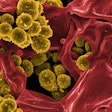
The proportion of people infected with COVID-19 missed by the Innova lateral flow test (LFT) is likely to be of clinical and public health importance, according to research published on February 23 in the BMJ. The findings also show the test is particularly prone to underestimating infections in people with lower viral loads, to whom the tests are often being applied.
In addition, although the public health benefits of using LFTs within asymptomatic screening programs might outweigh concerns about sensitivity, clinicians and policy makers must be aware of the limitations involved, and formal cost effectiveness analyses should be performed.
"Until new generation LFTs are available that meet the regulatory performance requirements, negative test results from LFTs cannot be relied on to exclude current infection," wrote Jonathan Deeks, PhD, and colleagues from the University of Birmingham in the U.K.
LFTs for detecting SARS-CoV-2 have been recommended for widespread use, largely based on predictions made by mathematical models. But while empirical data show LFTs give a positive result when virus is present on a swab in high quantities and can detect people who are likely to be infectious, the proportion missed who are infectious has not been evaluated.
Empirical data
The scientists drew on empirical data from several sources to predict the proportion of Innova LFTs that produce negative results in those with a high risk of SARS-CoV-2 infectiousness. They compared these with predictions made by mathematical models. For example, they identified research that reported the accuracy of the Innova LFT in real-world settings stratified by viral load or PCR cycle threshold (Ct) value, together with distributions of cases by viral load or Ct value in test settings.
The data analysis included testing in three settings: symptomatic testing at a U.K. National Health service (NHS) test-and-trace center, mass testing of Liverpool, U.K., residents without symptoms, and student testing at the University of Birmingham.
The analysis predicted that of those with a viral culture positive result, Innova would miss 20% of those tested at the center; 29% of those without symptoms who participated in the municipal mass testing; and 81% of university students screen-tested without symptoms, along with 38%, 47%, and 90% of sources of secondary cases -- those who acquired the virus from an infected individual.
The proportion missed had varied between settings because of different viral load distributions and was probably greatest in those without symptoms. Still, the proportion of infectious people with SARS-CoV-2 missed by LFTs was substantial enough to be of clinical importance, the scientists reported.
Two mathematical models underestimated the numbers of missed infectious people -- 8%, 10%, and 32% in the three test settings for one model.
The researchers noted that during an infection, viral load increases rapidly to a peak and then decreases more slowly. It was not possible for them to know if the Ct values were increasing or decreasing. In addition, the swabbing technique used might affect the quality of the sample and the relationships investigated in the analysis.
Applying LFTs for detecting COVID-19 has mushroomed worldwide. The tests are cheap and can quickly yield results. However, because dedicated studies of how LFTs perform are scarce, policy decisions on their use have been supported by mathematical models for the most part. But important assumptions have been made about the relationships between the distribution of viral load, estimates of diagnostic sensitivity, and measures of infectiousness, the scientists suggested.
"Simplistic" approaches have been adopted in which it is assumed that those with viral loads above a fixed threshold, usually assumed to be 106 copies per mL, are highly likely to be infectious, and those with viral loads at less than the threshold are assumed to have little infectious virus, the scientists indicated.
The same assumptions have been used to suggest that LFT sensitivity estimates should be recalibrated when detecting infectious disease. But these assumptions are not usually based on empirical data.
The assumptions also prompt claims that LFTs identify many currently infectious individuals and only give a negative result during the pre-infectious or post-infectious phases.
Lack of reference standard
It is a challenge to determine how well tests detect active SARS-CoV-2 infections because an accurate reference standard does not exist. Instead, the ability of the test to identify those with established markers for infectiousness -- positive viral culture result or sources of secondary cases -- can be evaluated. Using an analysis linking six sources of empirical evidence, the authors have shown that the current Innova LFT is predicted to miss substantial proportions of infectious individuals based on these established markers.
The investigators also asserted, "Key models have failed to appropriately use empirical evidence to inform assumptions of test accuracy and chances of infectiousness, resulting in unrealistic overestimates of test performance."
The researchers conclude that additional evaluation of LFT technology is needed, and until new generation LFTs meet regulatory performance requirements, negative test results from LFTs cannot be relied upon to completely exclude the potential of an individual being infected with COVID-19.



















